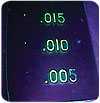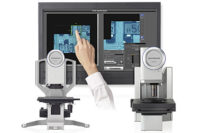
Fluorescent penetrant and other inspection processes requiring ultraviolet (UV) light incidence on the inspection surface have long provided quality assurance personnel with detailed information as to the condition of an operating assembly or detailed component part.
Using an illumination wand or hand helps UV lamps deliver high intensity UV light that provides the necessary energy to excite unique chemicals proliferating fluorescence for conventional “eyeball” external surface inspections.
UV inspection scenarios for those target areas not visible to the naked eye have presented a bit more of a challenge-often resulting in destructive visual fluorescent penetrant inspection (FPI) testing and the inevitable material and labor waste in scrapping parts used for a periodic inspection or random production sampling. The costs for the same are significant, and now can be avoided using a new videoscope technology.

The UV videoscope can articulate 90 degrees in four directions, allowing the inspector to access and completely view intricate component inspection areas. Source: Karl Storz
Videoscope Technology
Although fiberscopes and rigid borescopes configured with quartz illumination fibers have been employed to accomplish borescopic fluorescent penetrant remote visual inspections (FP-RVI), shortcomings include a lack of flexibility in the rigid borescope and lower resolution inherent to image bundles in fiberscopes. The requirements of fluorescent penetrant inspections typically dictate the necessity to resolve defects and indications as small as 0.001 inch, and newer imaging capabilities of the UV videoscope now offer the inspector confidence in making such determinations.Quartz fiber is known to possess the characteristics of high internal fiber reflection, maximizing efficient light transmission in the 365 nanometer wavelength. These fibers also provide the highest transmission of visible white light, often preferred for general inspection while seeking out UV inspection targets under borescopic white light illumination.
A fiber that consists of relatively high quartz content also may incorporate other materials that reduce the brittleness of the fiber, enhancing flexibility to the fiber. Therefore, these fibers lend themselves well to articulating borescopic inspection systems, specifically a UV videoscope.
A critical component of the UV videoscope is the ability to resolve detail. The UV videoscope incorporates a 1/6-inch charge-coupled device (CCD), containing more than 400,000 pixels for maximum resolution. In comparison to the conventional fiberscope, which may incorporate approximately 30,000 fibers (pixels), the UV videoscope presents an image of more than 10 times this theoretical resolution, or it resolves those critical defects 10 times better, including indications that are as minute as 0.001 inch.

UV videoscopes save thousands of dollars in scrap waste and in-process component or assembly manufacturing costs. Source: Karl Storz
Illumination
The illumination fibers also are of critical importance. Ultraviolet light transmission is maximized through high quartz content fibers, but also must be flexible enough to navigate confined and remote areas. The length of the fibers will dictate UV light attenuation (or loss) so optimizing length is important. The illumination fibers integral to the UV videoscope are of high quartz content, delivering surface light intensity that exceeds most requirements of the industrial and aviation markets.Given a special flexible, yet quartz-based fiber composition, the UV videoscope itself remains flexible and can articulate 90 degrees in four directions, allowing the inspector to access and completely view intricate component inspection areas.
The UV light is produced by a specially designed light source configured with a lamp producing a broad wavelength of light ranging from ultraviolet through the visible ranges, or from about 320 to 500 nanometers, with peak intensity at 365 nanometers-desirable and ideal for FPI.
An internal filter excludes white light when remotely positioned in front of the lamp, and yields less than two foot candles of white light under the UV inspection mode. Coupled with four-way articulation, the white light mode allows an operator to navigate to remote areas prior to switching to the UV illumination mode for the borescopic FPI.

The UV light is produced by a specially designed light source configured with a lamp producing a broad wavelength of light. Source: Karl Storz
Applications
Applications for UV videoscopes include FPI landing gear cylinder inspections where the eye cannot see deep into cavities subject to fatigue cracking. Internal structural components also fatigue over time, but the UV videoscope can provide a reach into doublers and frames for remote and nondestructive visual inspection.In the production world, machined parts and castings that ultimately accumulate many hours of labor may be periodically inspected for defects and indications prior to reaching final inspection and incurring full production cost.
The automotive marketplace uses a wax coating process to seal and inhibit oxidation and rust corrosion of critical strength support components. These wax seals may be inspected for complete coverage prior to market delivery using the UV videoscope. Additionally automotive inspections include engine block and cylinder head inspection.
In general, anywhere a destructive FPI is applied, UV videoscopes can help improve product quality and save thousands of dollars in scrap waste and in-process component or assembly manufacturing costs.
Documentation of the inspection is captured by a processor, or by one of many other configurations designed to meet the packaging and operational requirements of field, laboratory, bench-top or inspection shop users. High resolution, digital still images or MPEG videos may be recorded for collaboration or historical trend monitoring. Information may be shared via live Internet streaming, JPEG or MPEG export via USB ports, or networking the processor within an organizational or inspection environment.
By reducing waste and improving quality, UV videoscopes have provided another viable option to UV inspection. NDT
